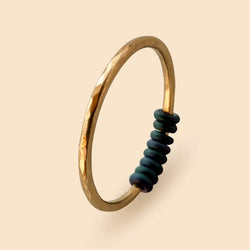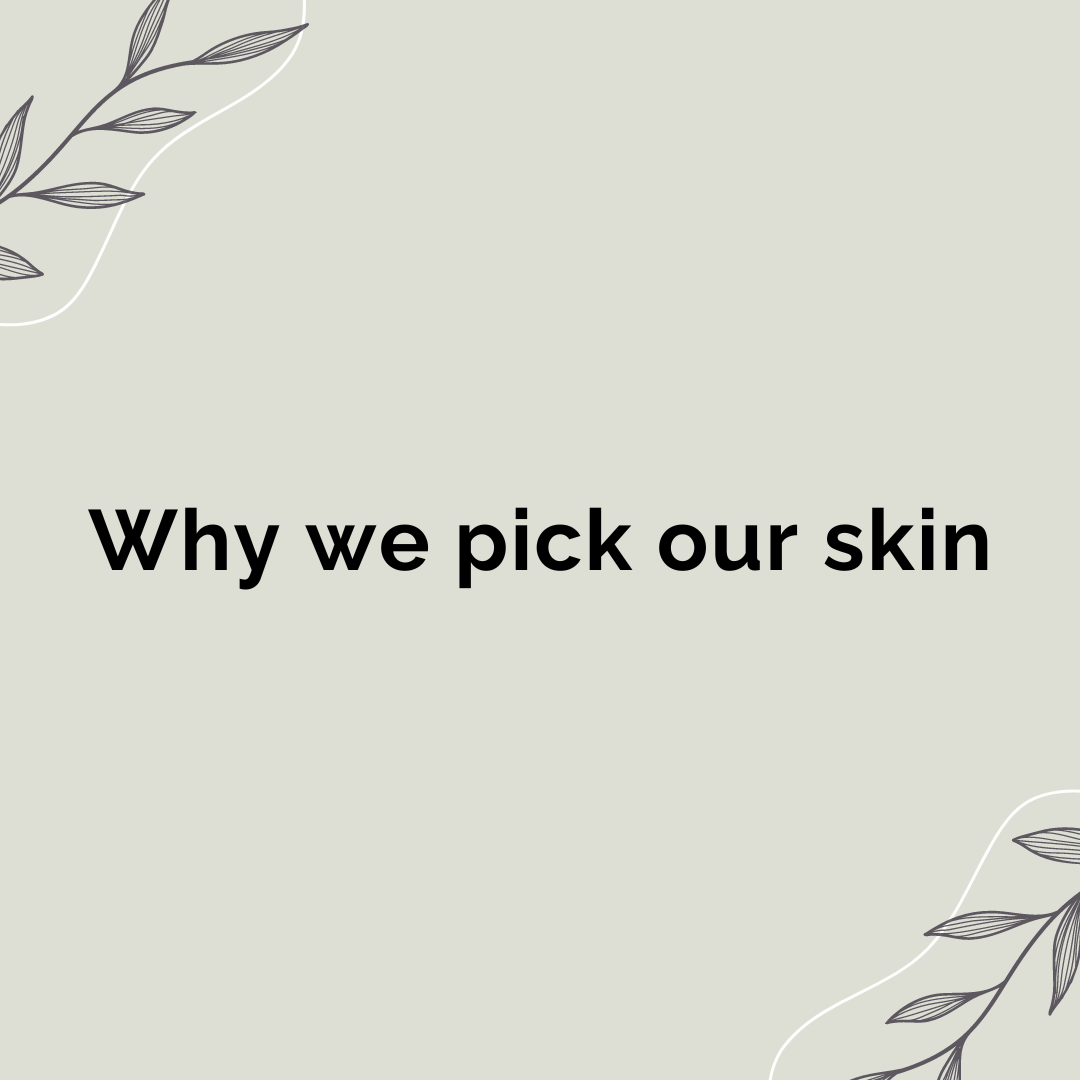Why we pick our skin
Have you ever wondered why we pick our cuticles, bite our nails, or shake our legs when we feel restless? In English-speaking countries, this behavior has a name: fidgeting .
Often there is stress mentioned as a trigger for skin picking.
Fidgeting can be a coping strategy to deal with tension or stress. For some people, skin picking is a way to relieve stress or anxiety. It's like an automatic reflex that brings some relief or satisfaction when we feel restless .
Research shows that emotions come with a physical response and arousal. [ 1 ] Suppressed feelings can also make people prone to skin picking. Instead of processing and expressing these feelings, skin picking can serve as a coping mechanism to deal with emotional distress. I myself have noticed that in stressful situations where I express my emotions, I don't pick my skin.
Why can skin picking cause relief or satisfaction? Skin picking can provide sensory stimulation by creating tactile stimuli. These stimuli can trigger pleasant sensations and calm the nervous system, balancing both under- and over-stimulation. This means that skin picking occurs not only with tension and stress but also with passive activities: e.g. B. when reading, when someone is talking or when you are bored. [ 3 ] [ 5 ]
Differences between occasional and compulsive skin picking
It's important to understand that not all forms of skin picking are compulsive. While some people pick their skin occasionally without it becoming a significant problem, others develop compulsive behavior that interferes with their lives. Psychological professionals call this compulsive behavior 'skin picking disorder' or 'dermatillomania' .
The transition from occasional skin picking to compulsive skin picking can be gradual and varies from person to person. If the pinching becomes an uncontrollable urge that interferes with daily life, it may be a warning sign. The intensity and duration of the behavior are also important factors.
You are not alone. Skin picking is very common and human.
In Germany one in six adults engage in skin picking or nail biting. Children and teenagers are even more likely to be affected. [ 4 ] Often the skin picking sensation begins in youth with the onset of acne, while in others the tingling sensation occurs between the ages of 30 and 45. [ 5 ] For me, acne during puberty was the start of my skin picking history. After my skin improved during my studies, my skin picking behavior relocated to the skin around my fingers. It's important to know that you're not alone when it comes to skin picking. There are ways to deal with it and find support.
Sources:
[1] Planet Knowledge. "Emotions - guides through life". Available at: https://www.planet-wissen.de/gesellschaft/psychologie/emotionen_wegweiser_durchs_leben
[2] Clinical Neuropsychology. "Habit replacement". Available at: https://clinical-neuropsychology.de/habit-replacement/
[3] Torin, T. (2021). Exploring Qualities in Smart Fidget Devices for Affective Regulation Support. KTH Royal Institute of Technology. Available at: https://www.diva-portal.org/smash/get/diva2:1586444/FULLTEXT01.pdf
[4] Technician health insurance. "Fingernail biting, picking, and other nail disorders". Available at: https://www.tk.de/techniker/magazin/life-balance/stress-bewaeltigen/fingernaegel-kauen-pulen-2098472
[5] Wikipedia. "Skin Picking Disorder". Available at: https://de.wikipedia.org/wiki/Skin_Picking_Disorder
Let customers speak for us
from 108 reviewsHabe meinen Ring jetzt seit ein paar Wochen und bin super happy damit. Er ist auch optisch einfach was besonderes.
Ich nutze vor allem das Drehen der großen Mondkugel häufig im Alltag.
Lieferung ging auch super schnell und der Ring war sehr liebevoll verpackt.
Überlege mir schon mir zu Weihnachten noch ein zweites Modell zu wünschen.

Der Fidget Ring ist sehr filigran und wahnsinnig schön. Ich habe ihn mit durchsichtigen Perlen bestellt, worin sich das Licht fängt und die Perlen super schön schimmern. Trage die Perlen daher seitlich und gerne auch vorne am Ring. Mit der schönste Ring, den ich besitze und das sogar mit Funktion 😍 Vielen lieben Dank, auch für die tolle Beratung im Vorfeld, den schnellen Versand und die liebevolle Verpackung 🤗

Die Lieferung (in die Schweiz) klappte problemlos und schnell. Der Ring ist sehr schön, angenehm zu tragen und erfüllt den Zweck. Ich hatte schon andere Fidget Ringe, die aber nicht ganz passten, die Perlen unförmig waren oder sonst unangenehm. Das ist bei diesem Ring ganz und gar nicht der Fall.

Ich nutze den Ring, um mich in Angst- und Anspannungssituationen zu regulieren und bin sehr begeistert! Er passt perfekt und ist nun zu meinem ständigen Begleiter geworden.

Der bestellte Ring ist schnell und gut bei mir angekommen. Die Verarbeitung ist klasse. Dies ist mein zweiter Ring, manchmal trage ich beide. Die Ringe helfen mir sehr gut, wenn es mir mal nicht gut geht.

Ich habe den Anden Fidget Ring in einer Sondergröße und mit weißen Perlen bestellt. Meine Anfrage wegen der Sondergröße und den weißen Perlen wurde sofort beantwortet und war gar kein Problem. Der Ring sieht schön aus und hält seit einigen Wochen dem Praxistest stand. Auf jeden Fall empfehlenswert! :)

Ich bin schwer begeistert. Ich habe schon 2 Ringe und sie sind wunderschön, filigran und angenehm zu tragen. Bei Fragen ist der Kontakt supernett, schnell und unkompliziert. Alles kam so liebevoll verpackt bei mir an.
Und noch wichtiger: Die Ringe helfen mir wirklich sehr, meine immer nervösen Finger zu beschäftigen. Ich trage ihn von aufstehen bis zum schlafen gehen.
Danke! <3

Ich habe mich schon beim Anschauen in die Ringe verliebt und wollte deshalb gleich zwei davon haben. Die Ringe waren sehr liebevoll verpackt und ich finde beide einfach wunderschön. Sie helfen mir bei innerer Unruhe, Anspannung und Ängsten. Ich habe mich gleich an die Ringe gewöhnt und bin sehr glücklich damit.

Wow! Der Ring ist so sauber verarbeitet. Filigran, aber doch ein Hingucker. Und vor allem helfen mir die Perlen im Alltag bei mir zu bleiben und wenn ich überreizt bin, Momente der Ruhe zu nehmen. Ich bin 100% zufrieden.

Ich liebe den Ring, er hilft mir total um nicht mehr an den Nägeln zu kauen. Dabei ist er super dezent und fällt wirklich kaum auf. Er ist im Alltag nicht mehr wegzudenken. Das wird definitiv nicht die letzte Bestellung gewesen sein!

Ich habe diesen Ring für meine Tochter gekauft. Sie hat bereits ein anderes Modell und ist sehr zufrieden. Sie trägt ihn immer, wenn es im Job sehr stressig ist und schwört auf die positive Wirkung.

Der Ring erfüllt meine Erwartungen und passt wirklich wie angegossen! Danke für die liebe Kommunikation und den schnellen Versand🌞

Ich suche schon lange nach einem unauffälligen, schönen Fidget Toy und dieser Ring ist einfach perfekt! Wenn man dazu noch ein kleines unabhängiges Ein-Frau-Unternehmen unterstützen kann, umso besser:)








